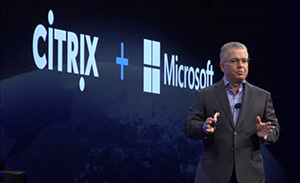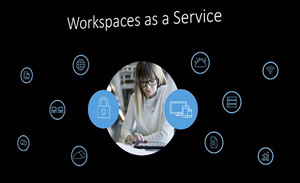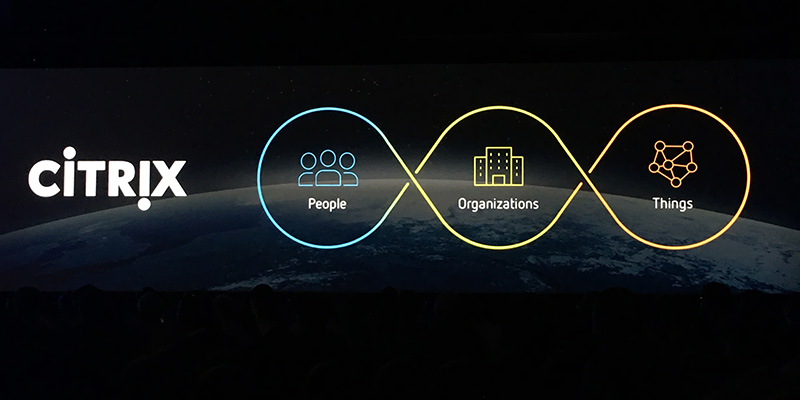Citrix Strategy revealed at Citrix Synergy 2016
Citrix Synergy is the premier industry conference on digital business transformation and brings the global Citrix community of customers, partners and industry influencers together for strategic insights and professional networking.
This year, blueAPACHE Managing Director, Chris Marshall and General Manager Commercial, James Hendry attended the event in Las Vegas, Nevada to meet with key Citrix executives, gain valuable insight to their product and technology strategies, and better understand how these could benefit our clients.
The underlying message this year was very much focused on their new cloud-first approach, new versions of their offerings, greater integration, and focus on the new Workspace-as-a-Service (WaaS). The big headline was the partnership between Citrix and Microsoft to help accelerate customers’ digital transformation, which for most people translates to a move to the cloud (private, public or hybrid) for their computing workloads.
Citrix and Microsoft
Kirill Tatarinov, CEO of Citrix, revealed that Citrix and Microsoft have expanded their strategic partnership to meet the needs of the modern workforce, with application and desktop virtualisation in the cloud, network delivery, and enterprise mobility management space. The organisations share one of the longest standing partnerships in the IT industry, dating back 25 years and including an equity investment to save the company back in the late 1990s.
 The new pact will see Citrix adopt Microsoft Azure public cloud to deliver all of Citrix’s new cloud service offerings. “We are in the midst of a very significant, very important transformation, from being a product focused company to being a solution provider, more importantly being able to deliver services from the cloud,” Tatarinov said in his keynote, adding that everything Citrix offers on-premises will also be available as a cloud service. “In the coming weeks and months you will see the entire Citrix portfolio of products and solutions move to the cloud, to enable virtualisation of applications on the desktop in the cloud, with consistent delivery, end-to-end on Citrix.”
The new pact will see Citrix adopt Microsoft Azure public cloud to deliver all of Citrix’s new cloud service offerings. “We are in the midst of a very significant, very important transformation, from being a product focused company to being a solution provider, more importantly being able to deliver services from the cloud,” Tatarinov said in his keynote, adding that everything Citrix offers on-premises will also be available as a cloud service. “In the coming weeks and months you will see the entire Citrix portfolio of products and solutions move to the cloud, to enable virtualisation of applications on the desktop in the cloud, with consistent delivery, end-to-end on Citrix.”
On the product side, integrating Citrix NetScaler with Azure for identity management / cloud networking and a Citrix-hosted “as-a-service” solution in Azure for its customers were some of the key announcements. Citrix and Microsoft are actively working together on new integrations between Citrix XenMobile, NetScaler and the Microsoft Enterprise Mobility Suite (EMS). The initial integration point disclosed by Citrix is around VPN access to enterprise applications by Intune-managed devices. This is great for prospective customers, but there could be some short-term confusion for Citrix customers while details are being ironed out.
Citrix Worx Mail and Forms applications, ShareFile enterprise file share and sync, and Citrix Receiver will support EMS, so that customers can manage and secure these mobile application experiences using the same management capabilities used in Office 365 and SAP Fiori.
ShareFile
Among the many announcements Tatarinov made were updates to Citrix’s enterprise-class file sync-and-share solution, ShareFile, which can run on any cloud, on-premises and hybrid IT infrastructure. Users can securely access data and documents on ShareFile, and if they have an Office 365 license, they can collaboratively edit the document in the cloud with other users, and the document can be saved back to ShareFile afterward.
“The extension to ShareFile integration and access is going to make it a lot more appealing to organisations in Australia” said Chris Marshall. “It already provides a comprehensive platform to easily, safely and securely share files, but will now have more deployment, governance and accessibility options.”
ShareFile now has information rights management, which lets data security “follow the file” even as it leaves the ShareFile system and is accessed on unprotected devices, USB drives, email attachments and any other file sharing system. When a file is shared with rights management protections, access to the file requires ShareFile authentication — even after the file has been downloaded. Tatarinov stated that Citrix is looking to expand to midmarket businesses, a segment that already heavily embraces the solution. ShareFile offers simplicity and elegance to SMBs, he said, adding that Citrix wants to take what it has done with ShareFile and apply it across its entire portfolio.
Workspaces as a Service and Citrix Cloud
Tatarinov discussed Citrix tools that he said will accelerate digital transformation efforts by delivering a unified Workspaces as a Service (WaaS), which he said is “a new mode of working that is cloud-enabled” and gives users the “ability to access technology, applications and data anywhere in the cloud, with Citrix being the conduit.”
The “Citrix Cloud” helps businesses manage services from the cloud and
unifies every major Citrix product, including Citrix NetScaler, ShareFile, XenApp, XenDesktop and XenMobile. These offerings are available individually, or can be accessed together as a unified WaaS solution. Data delivery over the cloud will not only be done securely, but also contextually.
Customers can also use Citrix AppDNA to accelerate migration to Windows 10 by discovering and resolving application compatibility issues early and comprehensively. This is critical for large-scale deployments like those by Citrix customers. Together, both organisations are continuing to help clients realise the collaboration and communications benefits of Office 365. Microsoft and Citrix customers will be able to use Skype for business delivered with the security of Citrix XenApp in XenDesktop virtual desktop infrastructure (VDI) environments.
New editions of proven solutions
Citrix used the event to announce a number of new products, including:
- New releases of its Xen desktop and application virtualisation portfolio (XenDesktop 7.9 and XenApp 7.9)
- A major upgrade to its NetScaler application delivery controller and network gateway
- A new management platform
In its flagship product set, Citrix announced XenServer 7 with support for both high-end and mainstream devices. On the high-end, Citrix now supports the Intel Iris Pro GPU, as demonstrated by devices such as the Dell Wyse 7040.
The company emphasised plans to bolster its XenMobile mobility management offering with what the company calls a “mobile application management (MAM)-First approach.”
Ultrathin clients
Citrix has also renewed commitment to Windows 10. Citrix showed a number of end-user examples where virtual machines (VDI) can leverage Windows 10 instances running in a cloud data centre with a thin- or ultra-thin (Raspberry Pi) client. Citrix’s partners, notably Dell, had live hardware and software demonstrations at the event.
Raspberry Pi running cloud-based Windows 10 certainly gained a lot of attention at the event, and cleverly reinforced the opportunity this partnership can bring to market.
“This was an exciting event for Citrix,” said Marshall. “We are looking forward to many of the changes, as they reflect our vision for tomorrow.”
blueAPACHE and Citrix have been partners for over 12 years providing application delivery solutions built on Citrix technologies. For further information on Citrix’s strategy and how these changes may impact your platforms, contact your blueAPACHE account manager.

